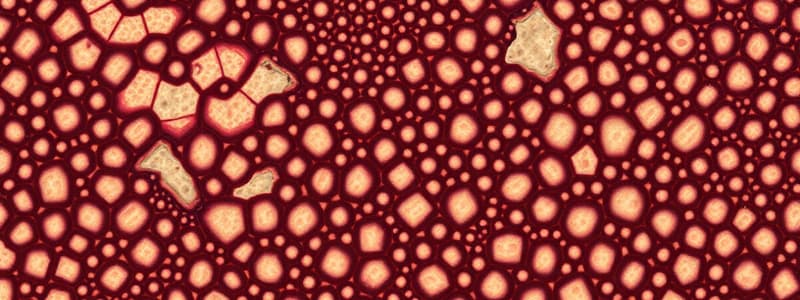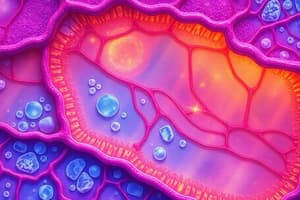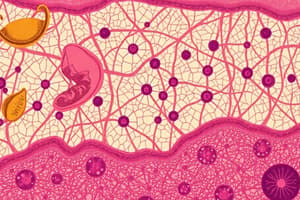Podcast
Questions and Answers
Which of the following are classified as the four major tissue types in the human body?
Which of the following are classified as the four major tissue types in the human body?
- Connective, Muscular, Nervous, Epithelial (correct)
- Epithelial, Dermal, Connective, Muscle
- Nervous, Bone, Cartilage, Epithelial
- Muscle, Glandular, Connective, Epidermal
What is a general characteristic of epithelial tissue?
What is a general characteristic of epithelial tissue?
- Highly vascular with a rich blood supply
- Exhibit polarity with different features on opposite sides (correct)
- Cells are loosely packed with large intercellular spaces
- Always present in the form of thick layers only
What is the function of the basement membrane in epithelial tissue?
What is the function of the basement membrane in epithelial tissue?
- To store nutrients for epithelial cells
- To provide a pathway for blood vessels
- To allow for the movement of epithelial cells
- To separate epithelial cells from connective tissue (correct)
Which type of epithelial tissue is specialized for secretion?
Which type of epithelial tissue is specialized for secretion?
What characteristic distinguishes covering and lining epithelium from other types?
What characteristic distinguishes covering and lining epithelium from other types?
Which type of epithelial tissue consists of a single layer of cells?
Which type of epithelial tissue consists of a single layer of cells?
What shape are the cells in cuboidal epithelium?
What shape are the cells in cuboidal epithelium?
Which characteristic is true of stratified epithelium?
Which characteristic is true of stratified epithelium?
Where can simple squamous epithelium typically be found?
Where can simple squamous epithelium typically be found?
What is a primary function of epithelial tissue?
What is a primary function of epithelial tissue?
Which type of epithelial tissue may contain mucus-secreting unicellular glands?
Which type of epithelial tissue may contain mucus-secreting unicellular glands?
Which of the following is NOT a characteristic of epithelial tissue?
Which of the following is NOT a characteristic of epithelial tissue?
What type of epithelial tissue is specialized for stretching and is found in the bladder?
What type of epithelial tissue is specialized for stretching and is found in the bladder?
Which of the following is NOT a characteristic of epithelial tissue?
Which of the following is NOT a characteristic of epithelial tissue?
What is the primary function of pseudostratified columnar epithelium?
What is the primary function of pseudostratified columnar epithelium?
What differentiates keratinized from nonkeratinized stratified squamous epithelium?
What differentiates keratinized from nonkeratinized stratified squamous epithelium?
Which layer of the basement membrane is closest to the epithelial cells?
Which layer of the basement membrane is closest to the epithelial cells?
Which of these locations would you most likely find nonkeratinized stratified squamous epithelium?
Which of these locations would you most likely find nonkeratinized stratified squamous epithelium?
What type of connective tissue fiber provides the strength and support to the tissue?
What type of connective tissue fiber provides the strength and support to the tissue?
Which of the following best describes the function of the basement membrane?
Which of the following best describes the function of the basement membrane?
Which statement about the extracellular matrix (ECM) is true?
Which statement about the extracellular matrix (ECM) is true?
Which major tissue type primarily serves to connect different parts of the body?
Which major tissue type primarily serves to connect different parts of the body?
What is a primary characteristic of epithelial tissue that distinguishes it from other tissue types?
What is a primary characteristic of epithelial tissue that distinguishes it from other tissue types?
Which type of epithelium is specialized for absorption and secretion and often has microvilli on its surface?
Which type of epithelium is specialized for absorption and secretion and often has microvilli on its surface?
What is the main structural feature of the basement membrane?
What is the main structural feature of the basement membrane?
In which of the following locations would you most likely find simple squamous epithelium?
In which of the following locations would you most likely find simple squamous epithelium?
Which type of epithelial tissue can stretch and is specifically found in the bladder?
Which type of epithelial tissue can stretch and is specifically found in the bladder?
What are the two main types of epithelial tissue?
What are the two main types of epithelial tissue?
Which of the following characteristics is TRUE about stratified epithelium?
Which of the following characteristics is TRUE about stratified epithelium?
What type of connective tissue is characterized by its loose arrangement of fibers and cells, allowing for flexibility and cushioning?
What type of connective tissue is characterized by its loose arrangement of fibers and cells, allowing for flexibility and cushioning?
Which characteristic best distinguishes dense connective tissue from loose connective tissue?
Which characteristic best distinguishes dense connective tissue from loose connective tissue?
Which of the following connective tissues is specialized for transportation of nutrients and gases?
Which of the following connective tissues is specialized for transportation of nutrients and gases?
What are proteoglycans primarily composed of?
What are proteoglycans primarily composed of?
Which type of loose connective tissue is primarily responsible for storing fat?
Which type of loose connective tissue is primarily responsible for storing fat?
Which of the following connective tissues provides structural support and contains a gel-like matrix?
Which of the following connective tissues provides structural support and contains a gel-like matrix?
What type of connective tissue forms a scaffolding to support other tissues and organs?
What type of connective tissue forms a scaffolding to support other tissues and organs?
Which type of dense connective tissue has a wave-like structure that allows for elasticity and strength?
Which type of dense connective tissue has a wave-like structure that allows for elasticity and strength?
Which component of the extracellular matrix is primarily responsible for providing strength and support to connective tissue?
Which component of the extracellular matrix is primarily responsible for providing strength and support to connective tissue?
Hyaluronic acid is a type of what component found in connective tissue?
Hyaluronic acid is a type of what component found in connective tissue?
What primary function is served by cilia present in pseudostratified columnar epithelium?
What primary function is served by cilia present in pseudostratified columnar epithelium?
Which type of epithelial tissue is characterized by having surface cells that are dead and packed with keratin?
Which type of epithelial tissue is characterized by having surface cells that are dead and packed with keratin?
Which of the following best describes the structural composition of the basement membrane?
Which of the following best describes the structural composition of the basement membrane?
Which of these organs is lined by nonkeratinized stratified squamous epithelium?
Which of these organs is lined by nonkeratinized stratified squamous epithelium?
What types of fibers are found in connective tissue and provide structure and support?
What types of fibers are found in connective tissue and provide structure and support?
Which characteristic is true of simple columnar epithelium?
Which characteristic is true of simple columnar epithelium?
What is the primary characteristic that distinguishes keratinized from nonkeratinized epithelium?
What is the primary characteristic that distinguishes keratinized from nonkeratinized epithelium?
Where is the extracellular matrix (ECM) primarily found in connective tissue?
Where is the extracellular matrix (ECM) primarily found in connective tissue?
Which location in the body is primarily lined by pseudostratified columnar epithelium?
Which location in the body is primarily lined by pseudostratified columnar epithelium?
What component forms the majority of the extracellular matrix (ECM)?
What component forms the majority of the extracellular matrix (ECM)?
What is the name given to the serosa that lines the outer part of the organs within the abdominopelvic cavity?
What is the name given to the serosa that lines the outer part of the organs within the abdominopelvic cavity?
Which statement accurately describes the distinction between the parietal and visceral peritoneum?
Which statement accurately describes the distinction between the parietal and visceral peritoneum?
What type of tissue is primarily responsible for lining body cavities and covering organs?
What type of tissue is primarily responsible for lining body cavities and covering organs?
Which type of epithelial tissue would you expect to find in areas where diffusion or filtration occurs?
Which type of epithelial tissue would you expect to find in areas where diffusion or filtration occurs?
Which of the following statements reflects the structure-function relationship in epithelial tissue?
Which of the following statements reflects the structure-function relationship in epithelial tissue?
What is the primary characteristic that distinguishes simple epithelial tissues?
What is the primary characteristic that distinguishes simple epithelial tissues?
Where would you typically find simple cuboidal epithelium in the human body?
Where would you typically find simple cuboidal epithelium in the human body?
Which epithelial tissue type is defined by multiple layers and is often found in areas subject to abrasion?
Which epithelial tissue type is defined by multiple layers and is often found in areas subject to abrasion?
What function is primarily associated with the simple squamous epithelium?
What function is primarily associated with the simple squamous epithelium?
What is a key structural feature of pseudostratified columnar epithelium?
What is a key structural feature of pseudostratified columnar epithelium?
Which type of epithelial tissue is specifically adapted for secretion and typically contains goblet cells?
Which type of epithelial tissue is specifically adapted for secretion and typically contains goblet cells?
Which of the following correctly identifies a function of endothelium?
Which of the following correctly identifies a function of endothelium?
What structural characteristic do stratified epithelium types share?
What structural characteristic do stratified epithelium types share?
What modification can be found in simple columnar epithelial cells to increase their surface area?
What modification can be found in simple columnar epithelial cells to increase their surface area?
Which characteristic is true for both simple and stratified epithelial tissues?
Which characteristic is true for both simple and stratified epithelial tissues?
Study Notes
Major Tissue Types
- Four primary tissue types: epithelial, connective, muscular, nervous.
- Tissue consists of similar cells performing common functions.
Epithelial Tissue Characteristics
- Two main types: glandular epithelium and covering & lining epithelium.
- Avascular nature: lacks blood supply; relies on underlying connective tissue for nutrients.
- Epithelial tissue is innervated and exhibits polarity with distinct apical and basal surfaces.
- Rapid cell reproduction enables quick healing and potential scarring.
Epithelial Tissue Classification
- Epithelial tissue categorized based on layers and cell shape:
- Layers:
- Simple: single layer
- Stratified: multiple layers
- Shape:
- Squamous: flat
- Cuboidal: cube-shaped
- Columnar: rectangular
- Layers:
- A single type can be arranged in different forms, each serving specific functions.
Locations and Functions of Epithelial Tissue
- Endothelium: lines blood vessels.
- Simple squamous: found in air sacs of lungs and kidney tubules; facilitates diffusion.
- Simple cuboidal: central nuclei; may contain goblet cells for mucus secretion.
- Simple columnar: found in digestive tract; may possess microvilli to enhance surface area.
- Stratified squamous:
- Keratinized: dead cells packed with keratin, forming the outer layer.
- Non-keratinized: alive cells, lining oral cavity and esophagus, providing flexibility.
- Pseudostratified columnar epithelium: appears stratified but is a single layer; lines upper respiratory passages with function in mucus secretion.
Basement Membrane Structure
- Thin, acellular structure that separates epithelium from connective tissue.
- Composed of two layers:
- Basal lamina: includes lamina lucida and lamina densa.
- Reticular lamina: connects the epithelium to underlying connective tissue.
Connective Tissue Structure
- Made of an extracellular matrix (ECM) primarily composed of water (90%) and organic molecules (10%).
- Contains three main fiber types:
- Collagen fibers: strongest and provide structural support.
- Elastic fibers: allow flexibility and stretch.
- Reticular fibers: form networks for support.
- Matrix-secreting cells include "-blast" for forming matrix and "-cyte" for maintaining it.
Tissue Types
- Four major tissue types: epithelial, connective, muscular, and nervous.
- Tissue is a group of similar cells collaborating to perform common functions.
Epithelial Tissue
- Divided into two main types: glandular epithelium (forms glands) and covering & lining epithelium (covers body surfaces).
- Epithelial cells are typically avascular but innervated, meaning they lack blood vessels while containing nerve supply.
- Cells exhibit polarity with distinct apical (top) and basal (bottom) surfaces.
- Rapid cell reproduction contributes to swift healing and regeneration.
Classification of Epithelial Tissue
- Classified by number of layers:
- Simple: single layer of cells.
- Stratified: multiple layers of cells.
- Classified by cell shape:
- Squamous: flat cells.
- Cuboidal: cube-shaped cells.
- Columnar: column-like cells.
Types and Functions of Epithelial Tissue
- Endothelium: lines blood vessels, aids in diffusion and filtration.
- Simple squamous: found in air sacs of lungs and kidney tubules, facilitates gas exchange and filtration.
- Nonkeratinized stratified squamous: lines moist body openings like the mouth and esophagus.
- Keratinized stratified squamous: forms protective outer layer of skin with dead, keratin-filled cells.
- Pseudostratified columnar epithelium: appears stratified but is a single layer, found in respiratory passages, functions in mucus secretion and movement.
Basement Membrane
- Thin, acellular layer located between epithelium and connective tissue.
- Composed of two distinct layers:
- Basal Lamina: includes lamina lucida and lamina densa.
- Reticular Lamina: provides support and connection to connective tissue.
Connective Tissue
- Characterized by an extracellular matrix (ECM) that consists of fibers and ground substance.
- Contains three main fiber types:
- Collagen fibers: strong and provide structural support.
- Elastic fibers: provide flexibility.
- Reticular fibers: form networks for tissue support.
- Diverse types include loose (areolar, adipose, reticular) and dense (regular, irregular, elastic) connective tissues.
Loose and Dense Connective Tissue
- Loose connective tissue: includes areolar, adipose, and reticular tissue, provides space for vessels and nerves.
- Dense connective tissue: stronger and more fibrous, includes regular (tendons), irregular (dermis), and elastic types.
Exocrine Glands
- Classifications based on structure (tubular, acinar) and function (merocrine, holocrine, apocrine).
- Exocrine glands secrete substances through ducts to the epithelial surface.
Studying That Suits You
Use AI to generate personalized quizzes and flashcards to suit your learning preferences.
Related Documents
Description
Explore the characteristics, classification, and functions of epithelial tissue through this quiz. Understand the various types of epithelial tissue, their structures, and their unique roles in the body. Test your knowledge on how epithelium is essential for protection, absorption, and secretion.




